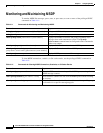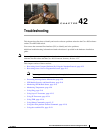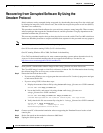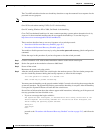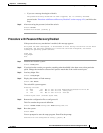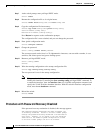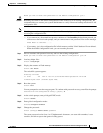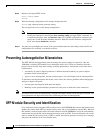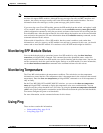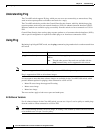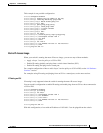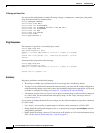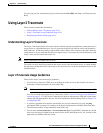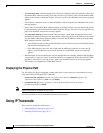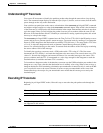
42-8
Cisco ME 3400 Ethernet Access Switch Software Configuration Guide
OL-9639-06
Chapter 42 Troubleshooting
Preventing Autonegotiation Mismatches
Step 8 Return to privileged EXEC mode:
Switch (config)# exit
Switch#
Step 9 Write the running configuration to the startup configuration file:
Switch# copy running-config startup-config
The new password is now in the startup configuration.
Note This procedure is likely to leave your switch virtual interface in a shutdown state. You can
identify this interface by entering the show running-config privileged EXEC command. To
re-enable the interface, enter the interface vlan vlan-id global configuration command, and
specify the VLAN ID of the shutdown interface. With the switch in interface configuration
mode, enter the no shutdown command.
Step 10 You must now reconfigure the switch. If the system administrator has the backup switch and VLAN
configuration files available, you should use those.
Preventing Autonegotiation Mismatches
The IEEE 802.3ab autonegotiation protocol manages the switch settings for speed (10, 100, and
1000
Mbps, excluding SFP module ports) and duplex (half or full). There are situations when this
protocol can incorrectly align these settings, reducing performance. A mismatch occurs under these
circumstances:
• A manually set speed or duplex parameter is different from the manually set speed or duplex
parameter on the connected port.
• A port is set to autonegotiate, and the connected port is set to full duplex with no autonegotiation.
To maximize switch performance and ensure a link, follow one of these guidelines when changing the
settings for duplex and speed:
• Let both ports autonegotiate both speed and duplex.
• Manually set the speed and duplex parameters for the ports on both ends of the connection.
Note If a remote device does not autonegotiate, configure the duplex settings on the two ports to match. The
speed parameter can adjust itself even if the connected port does not autonegotiate.
SFP Module Security and Identification
Cisco small form-factor pluggable (SFP) modules have a serial EEPROM that contains the module serial
number, the vendor name and ID, a unique security code, and cyclic redundancy check (CRC). When an
SFP module is inserted in the switch, the switch software reads the EEPROM to verify the serial number,
vendor name and vendor ID, and recompute the security code and CRC. If the serial number, the vendor
name or vendor ID, the security code, or CRC is invalid, the software generates a security error message
and places the interface in an error-disabled state.



